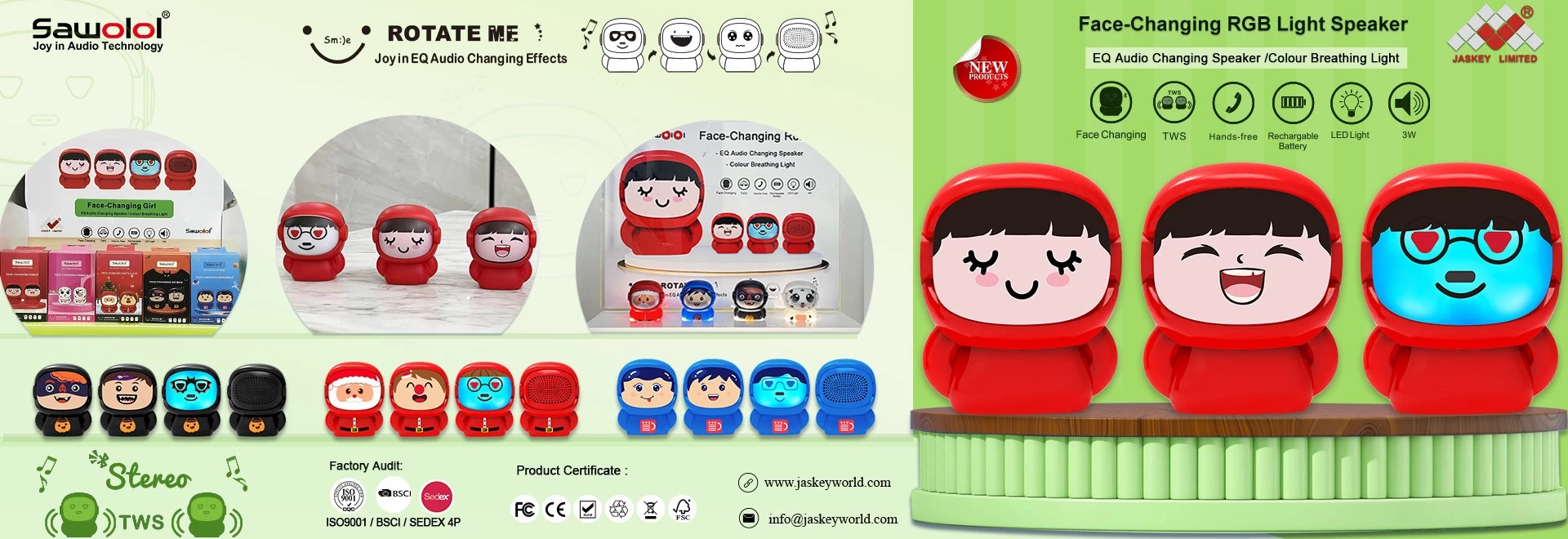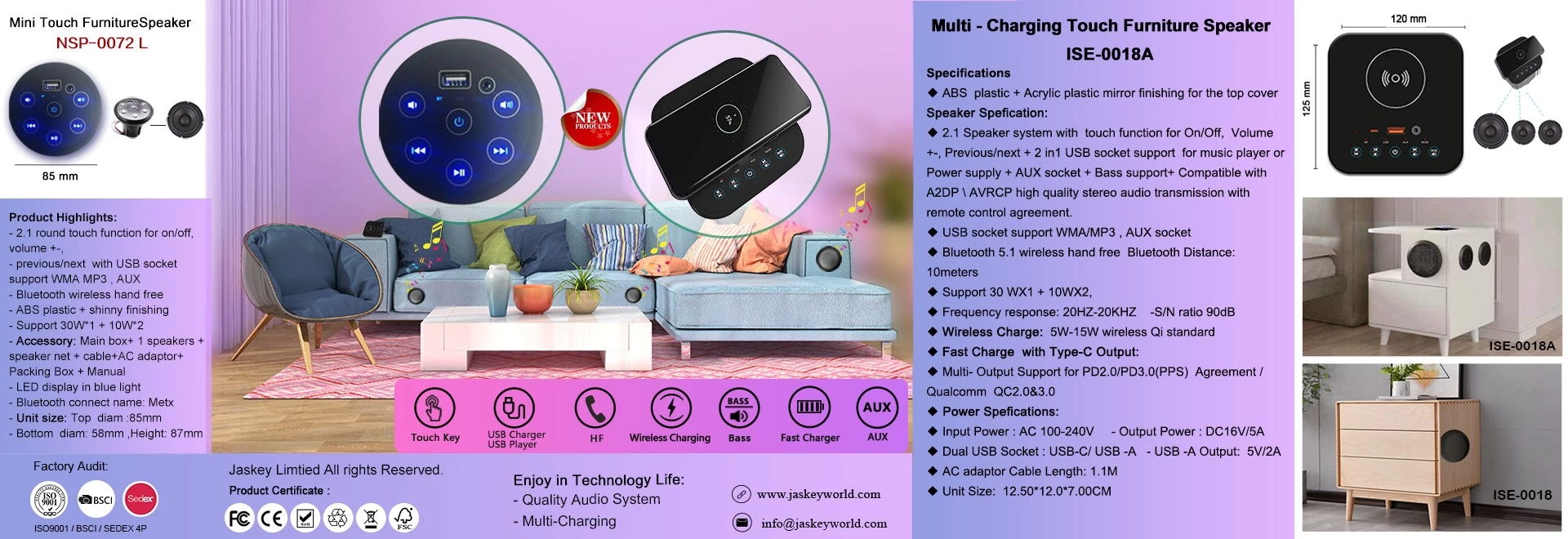What are the laws and effects in audio speaker technology?
Hedy
2021-09-22 14:47:37
1. Subjective perception in the frequency domain
The most important subjective feeling in the frequency domain is pitch. Like loudness, pitch is also a subjective psychological quantity of hearing, which is the attribute of hearing to judge the height of the sound.
The difference between tone in psychology and scale in music is that the former is the tone of pure tones, while the latter is the tone of composite sounds such as music. The pitch of a composite sound is not only a frequency analysis, but also a function of the auditory nervous system, which is affected by the listener's listening experience and learning.
2. Subjective feelings in the time domain
If the duration of the sound exceeds about 300ms, the increase or decrease of the duration of the sound has no effect on the change of the auditory threshold. The perception of tone is also related to the duration of the sound. When the sound lasts for a short time, no tone can be heard, just a "click" sound. Only when the sound lasts for more than tens of milliseconds can the tone feel stable.
Another subjective sensory characteristic of the time domain is echo.

3. The subjective perception of the spatial domain
Binaural listening for human ears has obvious advantages over monaural listening. It has high sensitivity, low listening valve, a sense of direction to the sound source, and strong anti-interference ability. Under stereo conditions, the sense of space obtained by listening with speakers and stereo headphones is different. The sound heard by the former seems to be located in the surrounding environment, while the sound heard by the latter is located inside the head. In order to distinguish between the two The sense of space, the former is called orientation, and the latter is called positioning.
4. Weber's law of hearing
Weber's law indicates that the subjective perception of human ears is proportional to the logarithm of the objective stimulus. When the sound is small and the amplitude of the sound wave is increased, the subjectively perceived volume of the human ear increases by a larger amount; when the sound intensity is greater and the same sound wave amplitude is increased, the increase in the subjectively perceived volume of the human ear is smaller.
According to the above-mentioned listening characteristics of the human ear, it is required to use an exponential potentiometer as a volume controller when designing a volume control circuit, so that when the potentiometer handle is evenly rotated, the volume increases linearly.
5. Ohm's law of hearing
The famous scientist Ohm discovered Ohm's law in electricity, and at the same time he also discovered Ohm's law in human hearing. This law reveals that the human ear's hearing is only related to the frequency and intensity of the sound The phase between the tones is irrelevant. According to this law, the process of recording and playback in the audio system can be controlled without considering the phase relationship of the partial tones in the complex sound.
The human ear is a frequency analyzer, which can separate the homophony in the polyphony. The human ear has a high sensitivity to frequency resolution. At this point, the human ear has a higher resolution than the eye, and the human eye cannot see all kinds of white light. Color light components.
6. Masking effect
Other sounds in the environment will reduce the listener's hearing of a certain sound, which is called masking. When the intensity of one sound is much greater than that of the other sound, and when the two sounds exist at the same time, people can only hear the sound of the loud one, but cannot perceive the existence of the other sound. The amount of masking is related to the sound pressure of the masking sound. As the sound pressure level of the masking sound increases, the amount of masking increases accordingly. In addition, the masking range of low-frequency sounds is larger than that of high-frequency sounds.
This auditory characteristic of the human ear provides important inspiration for the design of noise reduction circuits. In tape playback, there is such a listening experience. When the music program is continuously changing and the sound is loud, we will not hear the background noise of the tape, but when the music program ends (blank tape), we can feel The "his..." noise to the tape is present.
In order to reduce the influence of noise on the sound of the program, the concept of signal-to-noise ratio (SN) is proposed, that is, the signal strength is required to be sufficiently greater than the noise strength, so that the listening will not feel the presence of noise. Some noise reduction systems are designed using the principle of masking effect.
7. Binaural effect
The basic principle of the binaural effect is this: if the sound comes from directly in front of the listener, at this time, since the distance from the sound source to the left and right ears is equal, the time difference (phase difference) and tone color difference for the sound wave to reach the left and right ears is Zero, at this time, the sound is felt from the front of the listener, rather than to one side. When the sound is different, you can feel the distance between the sound source and the listener.
The most important subjective feeling in the frequency domain is pitch. Like loudness, pitch is also a subjective psychological quantity of hearing, which is the attribute of hearing to judge the height of the sound.
The difference between tone in psychology and scale in music is that the former is the tone of pure tones, while the latter is the tone of composite sounds such as music. The pitch of a composite sound is not only a frequency analysis, but also a function of the auditory nervous system, which is affected by the listener's listening experience and learning.
2. Subjective feelings in the time domain
If the duration of the sound exceeds about 300ms, the increase or decrease of the duration of the sound has no effect on the change of the auditory threshold. The perception of tone is also related to the duration of the sound. When the sound lasts for a short time, no tone can be heard, just a "click" sound. Only when the sound lasts for more than tens of milliseconds can the tone feel stable.
Another subjective sensory characteristic of the time domain is echo.

3. The subjective perception of the spatial domain
Binaural listening for human ears has obvious advantages over monaural listening. It has high sensitivity, low listening valve, a sense of direction to the sound source, and strong anti-interference ability. Under stereo conditions, the sense of space obtained by listening with speakers and stereo headphones is different. The sound heard by the former seems to be located in the surrounding environment, while the sound heard by the latter is located inside the head. In order to distinguish between the two The sense of space, the former is called orientation, and the latter is called positioning.
4. Weber's law of hearing
Weber's law indicates that the subjective perception of human ears is proportional to the logarithm of the objective stimulus. When the sound is small and the amplitude of the sound wave is increased, the subjectively perceived volume of the human ear increases by a larger amount; when the sound intensity is greater and the same sound wave amplitude is increased, the increase in the subjectively perceived volume of the human ear is smaller.
According to the above-mentioned listening characteristics of the human ear, it is required to use an exponential potentiometer as a volume controller when designing a volume control circuit, so that when the potentiometer handle is evenly rotated, the volume increases linearly.
5. Ohm's law of hearing
The famous scientist Ohm discovered Ohm's law in electricity, and at the same time he also discovered Ohm's law in human hearing. This law reveals that the human ear's hearing is only related to the frequency and intensity of the sound The phase between the tones is irrelevant. According to this law, the process of recording and playback in the audio system can be controlled without considering the phase relationship of the partial tones in the complex sound.
The human ear is a frequency analyzer, which can separate the homophony in the polyphony. The human ear has a high sensitivity to frequency resolution. At this point, the human ear has a higher resolution than the eye, and the human eye cannot see all kinds of white light. Color light components.
6. Masking effect
Other sounds in the environment will reduce the listener's hearing of a certain sound, which is called masking. When the intensity of one sound is much greater than that of the other sound, and when the two sounds exist at the same time, people can only hear the sound of the loud one, but cannot perceive the existence of the other sound. The amount of masking is related to the sound pressure of the masking sound. As the sound pressure level of the masking sound increases, the amount of masking increases accordingly. In addition, the masking range of low-frequency sounds is larger than that of high-frequency sounds.
This auditory characteristic of the human ear provides important inspiration for the design of noise reduction circuits. In tape playback, there is such a listening experience. When the music program is continuously changing and the sound is loud, we will not hear the background noise of the tape, but when the music program ends (blank tape), we can feel The "his..." noise to the tape is present.
In order to reduce the influence of noise on the sound of the program, the concept of signal-to-noise ratio (SN) is proposed, that is, the signal strength is required to be sufficiently greater than the noise strength, so that the listening will not feel the presence of noise. Some noise reduction systems are designed using the principle of masking effect.
7. Binaural effect
The basic principle of the binaural effect is this: if the sound comes from directly in front of the listener, at this time, since the distance from the sound source to the left and right ears is equal, the time difference (phase difference) and tone color difference for the sound wave to reach the left and right ears is Zero, at this time, the sound is felt from the front of the listener, rather than to one side. When the sound is different, you can feel the distance between the sound source and the listener.










